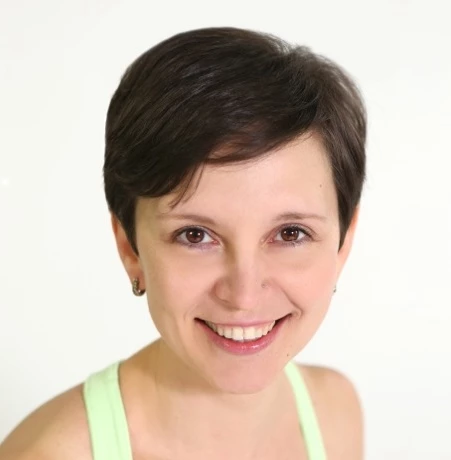Yoga for Chronic Pain: How to Use Your Mind to Work with Pain

According to Walter Freeman, one of the great neuroscientists, “All the brain can know it knows from inside itself.” This means that every thought and sensation you experience is your brain’s interpretation of what’s going on based on context and past experience. This point is essential when you work with chronic pain of any kind.
Even when the actual tissue damage heals, the mind doesn’t always get the memo. So whichever type of pain you are working with, you need to include the tools that address the mind.

So ultimately our goal is to deal with the body and heal the mind. Dealing with the body includes using asana practice to relieve tension, provide movement re-education and increase body awareness, as well as using breathing practices to affect energy and physiology. Healing the mind involves working with the mind’s perception of your experience to diminish suffering.
Strategies for Working with Chronic Pain via the Mind
-
Begin and end your yoga practice in a position that is completely comfortable and pain-free (if possible). This shows the mind that it is possible to be without pain.
-
Deepen your breathing and, when appropriate, emphasize exhalations to promote parasympathetic activation.
-
Identify potential inner obstacles that might be manifesting as physical symptoms and develop strategies for dealing with those obstacles.
-
Reframe your attitude toward pain; emphasize aspects of reality that enhance your well-being and facilitate healing (pratipaksha bhavana).
-
Practice bringing your attention into the body and observing your sensations to switch from the “narrative brain circuitry” to “direct experience” When you are in the “direct experience” mode you perceive the world as it is, instead of interpreting and analyzing it.
-
Empower yourself (or your student). Demonstrate that change toward better is possible. This can be accomplished by bringing your attention to small victories.
-
When working with a teacher, cultivate a trusting and supportive student-teacher relationship: “We are in this together and we will figure this out” as opposed to “I will fix you.”
-
Use chanting (in Sanskrit or native language), relevant text study and meditation to impact the mind. Some traditional options for meditation include:
-
Cultivating a positive attitude toward others (or lovingkindness meditations)
-
Focusing on prolonged exhalation and suspension of breath
-
Cultivating objective sensory perception
-
Meditating on the light
-
Turning to inspirational people
-
Observing dreams
-
Focusing on something that’s meaningful to you.

The most important thing that we need to accomplish when we work with chronic pain is to break our identification with it: “I am not my pain”. This is a fundamental change in one’s self-perception. It reframes the pain as something that does not define your identity and can be dealt with using specific tools. It is a very empowering realization.
More on working with Pain on the level of memory from YogaUOnline and Olga Kabel – Sing Out! How Chanting Trains your Brain.
Study core strength and so much more with Olga Kabel and YogaUOnline – Yoga for Posture Improvement with Focus on Core Strengthening and Axial Extension.
Reprinted with permission from Sequence Wiz.
 Educated as a school teacher, Olga Kabel has been teaching yoga for over 14 years. She completed multiple Yoga Teacher Training Programs but discovered the strongest connection to the Krishnamacharya/ T.K.V. Desikachar lineage. She had studied with Gary Kraftsow and American Viniyoga Institute (2004-2006) and received her Viniyoga Teacher diploma in July 2006 becoming an AVI-certified Yoga Therapist in April 2011. Olga is a founder and managing director of Sequence Wiz- a web-based yoga sequence builder that assists yoga teachers and yoga therapists in creating and organizing yoga practices. It also features simple, informational articles on how to sequence yoga practices for maximum effectiveness. Olga strongly believes in the healing power of this ancient discipline on every level: physical, psychological, and spiritual. She strives to make yoga practices accessible to students of any age, physical ability and medical history specializing in helping her students relieve muscle aches and pains, manage stress and anxiety, and develop mental focus.
Educated as a school teacher, Olga Kabel has been teaching yoga for over 14 years. She completed multiple Yoga Teacher Training Programs but discovered the strongest connection to the Krishnamacharya/ T.K.V. Desikachar lineage. She had studied with Gary Kraftsow and American Viniyoga Institute (2004-2006) and received her Viniyoga Teacher diploma in July 2006 becoming an AVI-certified Yoga Therapist in April 2011. Olga is a founder and managing director of Sequence Wiz- a web-based yoga sequence builder that assists yoga teachers and yoga therapists in creating and organizing yoga practices. It also features simple, informational articles on how to sequence yoga practices for maximum effectiveness. Olga strongly believes in the healing power of this ancient discipline on every level: physical, psychological, and spiritual. She strives to make yoga practices accessible to students of any age, physical ability and medical history specializing in helping her students relieve muscle aches and pains, manage stress and anxiety, and develop mental focus.



